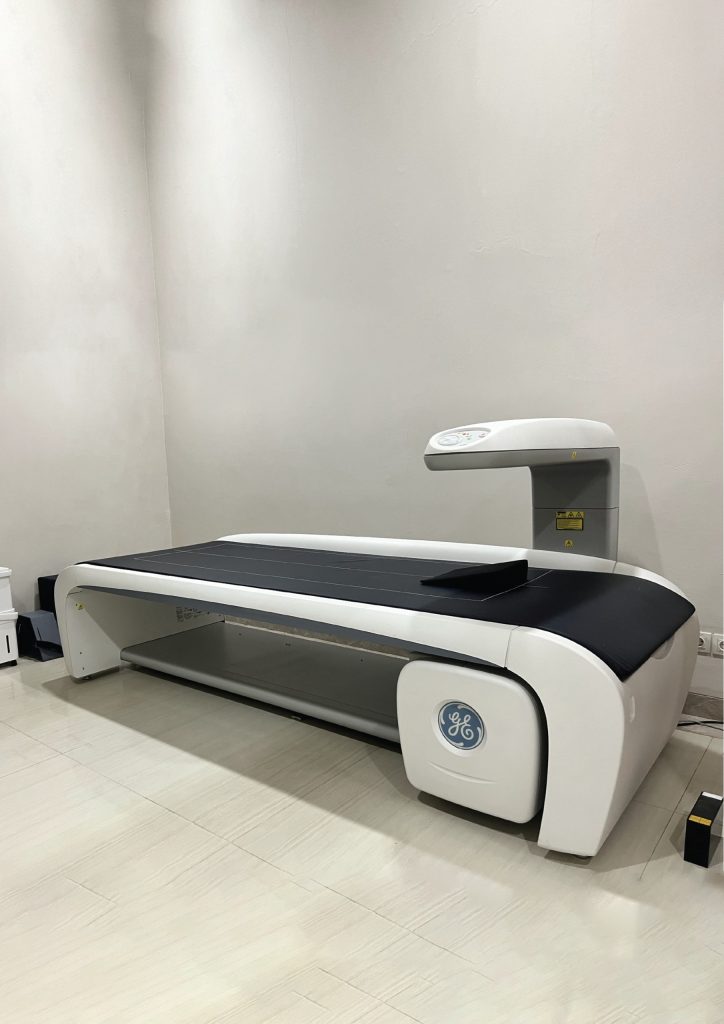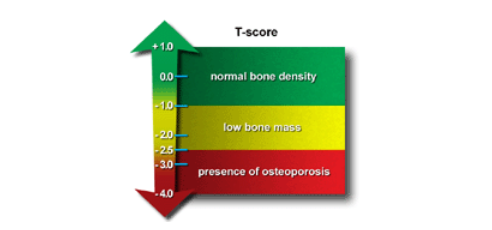Oleh: Thalia Kaylyn Averil
Bone Mineral Density (BMD) atau kepadatan mineral tulang yang menggunakan Dual-energy X-ray Absorptiometry (DXA) adalah metode skrining untuk penilaian risiko terjadinya patah tulang yang telah diakui secara global. Kepadatan mineral tulang dapat dinilai berdasarkan jumlah kalsium dan mineral lain di wilayah tertentu pada tulang. Prosedur ini dapat mendeteksi osteoporosis atau pengeroposan tulang dan menentukan risiko patah tulang pada pasien.

Gambar 1. BMD-DXA di Rumah Sakit Abdi Waluyo.
Tulang terdiri dari bahan anorganik seperti kalsium dan fosfat, serta komponen organik seperti kolagen dan protein. Tulang adalah jaringan dinamis yang terus-menerus diperbaharui oleh sel-sel yang disebut osteoklas dan osteoblas. Keseimbangan antara sel-sel ini menentukan kesehatan tulang. Osteoporosis terjadi ketika lebih banyak pengeroposan tulang akibat kerusakan dibandingkan pembentukan tulang baru. Ketidakseimbangan ini dapat terjadi meskipun laju pembentukan tulang normal atau bahkan tinggi. Di lain sisi, osteopenia adalah suatu kondisi pengeroposan tulang yang lebih ringan dibandingkan dengan osteoporosis. BMD-DXA adalah metode pengukuran massa tulang yang aman dan dapat memprediksi risiko patah tulang. BMD rendah dikaitkan dengan peningkatan risiko terjadinya patah tulang, sedangkan peningkatan BMD berhubungan dengan penurunan risiko patah tulang. Organ tubuh yang paling sering dilakukan prosedur BMD-DXA adalah tulang belakang bagian bawah, pergelangan tangan, dan pinggul karena tulang-tulang pada bagian tersebut adalah tulang yang paling rentan patah karena osteoporosis.
Untuk mendiagnosis dan mengobati osteoporosis dan osteopenia sesegera mungkin, BMD-DXA dapat dilakukan untuk memeriksa kondisi-kondisi berikut. Patah tulang akibat osteoporosis menimbulkan dampak yang serius, terutama bagi lansia. Jika didiagnosis cukup dini, osteoporosis dapat dicegah agar tidak bertambah buruk lebih cepat dengan pengobatan sehingga terhindar dari risiko patah tulang. Tes kepadatan tulang dapat digunakan untuk:
- Memastikan diagnosis osteoporosis, terutama jika sebelumnya Anda pernah mengalami patah tulang.
- Memprediksi kemungkinan Anda mengalami patah tulang di masa depan.
- Menentukan tingkat pengeroposan tulang Anda.
- Memeriksa efektivitas pengobatan Anda.
BMD-DXA atau tes kepadatan tulang memiliki beberapa indikasi, terutama berdasarkan faktor risiko osteoporosis. Faktor risiko khas osteoporosis di antaranya adalah:
- Pria berusia di atas 70 tahun dan wanita berusia di atas 65 tahun
- Wanita pascamenopause
- Merokok
- Mengonsumsi alkohol secara berlebihan
- Indeks massa tubuh (BMI) rendah
- Memiliki riwayat keluarga yang mengalami patah tulang di bagian pinggul
- Menggunakan steroid dalam jangka panjang
- Memiliki penyakit- penyakit seperti hipertiroidisme, hiperparatiroidisme, rheumatoid arthritis, diabetes mellitus tipe 1, penyakit hati, atau penyakit ginjal
Pada hasil tes BMD-DXA, kepadatan mineral tulang Anda akan dibandingkan dengan orang dewasa muda berusia sekitar 25 sampai 35 tahun yang sehat sehingga akan memperlihatkan hasil yang disebut dengan T-score. Selain itu, kepadatan mineral tulang juga akan dibandingkan dengan orang dewasa berusia sama yang akan menghasilkan Z-score. Perbedaan antara kepadatan mineral tulang Anda dan kepadatan mineral tulang lainnya disebut sebagai standar deviasi (SD). Jika T-score suatu tulang positif, berarti tulang tersebut lebih kuat dari normalnya dan tulang tersebut lebih lemah dari normalnya jika T-score negatif. Untuk Z-score, rumus yang sama digunakan untuk menghitung Z-score, tetapi perbandingan dibuat dengan orang-orang yang mirip dengan Anda dalam hal tinggi badan, berat badan, ras, jenis kelamin, dan usia.
Berdasarkan World Health Organization (WHO), osteoporosis dihubungkan dengan tingkat kepadatan tulang:
- Kepadatan tulang yang normal ditunjukkan dengan T-score yang berada pada kisaran 1 SD (+1 atau -1) dari rata-rata orang dewasa muda.
- Kepadatan tulang yang rendah ditandai dengan T-score pada 1 hingga 2,5 SD di bawah rata-rata orang dewasa muda (-1 hingga -2,5 SD).
- Osteoporosis muncul jika T-score 2,5 SD atau lebih di bawah rata-rata orang dewasa muda (lebih dari -2,5 SD).
Untuk setiap standar deviasi di bawah normal, risiko patah tulang umumnya meningkat dua kali lipat. Setelah mendapatkan hasil BMD-DXA, individu yang memiliki risiko tinggi mengalami patah tulang dapat diobati sehingga dapat mencegah patah tulang di masa depan. Jika seseorang pernah mengalami satu atau lebih patah tulang akibat osteoporosis dan kepadatan tulangnya 2,5 SD lebih rendah dibandingkan rata-rata orang dewasa muda, maka orang tersebut kemungkinan besar telah menderita osteoporosis parah.

Gambar 2. Interpretasi T-score pada BMD-DXA.
Apa saja yang perlu disiapkan untuk BMD-DXA?
- Pasien perlu berbaring terlentang selama kurang lebih sepuluh menit.
- Pasien tidak disarankan untuk mengonsumsi suplemen kalsium sehari sebelum tes.
- Pasien yang sedang mengalami menopause disarankan untuk melakukan tes kehamilan terlebih dahulu.
- Pasien sebaiknya menggunakan pakaian yang longgar dan nyaman, hindari pakaian dengan aksesoris logam, seperti ritsleting.
Referensi:
- Haseltine KN, Chukir T, Smith PJ, Jacob JT, Bilezikian JP, Farooki A. Bone Mineral Density: Clinical Relevance and Quantitative Assessment. J Nucl Med [Internet]. 2021 Apr [cited 2024 Feb 24];62(4):446-54. Available from: https://www.ncbi.nlm.nih.gov/pmc/articles/PMC8049374/
- Krugh M, Langaker MD. Dual-Energy X-Ray Absorptiometry. [Updated 2023 Jun 5]. In: StatPearls [Internet]. Treasure Island (FL): StatPearls Publishing; 2024 Jan-. Available from: https://www.ncbi.nlm.nih.gov/books/NBK519042/
- Johns Hopkins Medicine. Bone Densitometry [Internet]. Baltimore: Johns Hopkins Medicine; date of publication unknown [cited 2024 Feb 24]. Available from: https://www.hopkinsmedicine.org/health/treatment-tests-and-therapies/bone-densitometry
